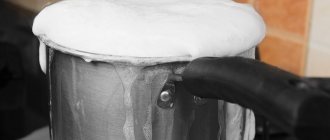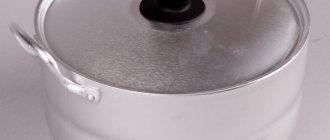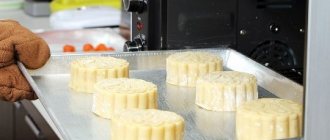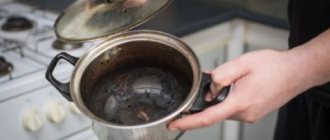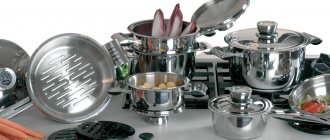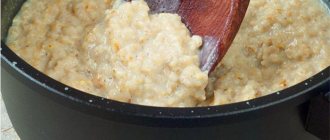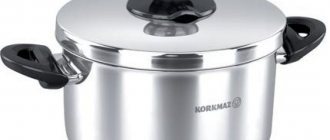It's burnt again... Is it possible to quickly and effectively clean enamel dishes from burnt jam, completely remove carbon deposits, and return to their original cleanliness.
If you're too lazy, the sugar overheats and turns into thick caramel.
These questions are often asked by housewives who decide to cook jam in an enamel-coated pan. The porous structure of the enamel coating is the main cause of burning. Among others, inattention, lack of time to follow the rules for preparing jam. As a result, a search for information on the topic: “How to clean an enamel pan from burnt jam.”
Enamel cookware is beautiful. The coating is not afraid of food acids, vitamins are not destroyed by contact with metal.
Why choose enamel cookware?
Enamel cookware is widely known and has been used for 180 years. Even with the advent of microwave ovens and other smart appliances, it has not lost its relevance and popularity. It is made from different types of metal, which is coated with enamel during processing.
Housewives traditionally use enamel-coated pans to make jam.
The undeniable advantages of such dishes:
- The safety of cooked food is ensured by the enamel coating;
- durability of use when handled correctly;
- enamel stability in acidic and alkaline environments is important for product selection;
- ease of care;
- a wide choice of design, style, color to decorate any kitchen;
- The affordable price ensures wide distribution.
Removing carbon deposits from coffee grounds
- We will need 2 tbsp. spoons of soda and citric acid, as well as 1/2 cup of whiteness;
- Mix the “ingredients”;
- Add 1/2 cup warm water;
- Put on fire, bring to a boil;
- Boil for 15 minutes;
- Leave to cool (20 minutes will be enough);
- Rinse the pan without additional detergents.
After this, wash the pan with vinegar or citric acid and rinse in running water. Your pan is like new!
Why does food burn in enamel dishes?
The enamel coating applied to metal has a porous structure. Product particles get into the micropores. Remaining in one place, food particles begin to burn, sometimes to the point of charcoal. More and more are added to the particles that begin to burn. If the temperature regime is not observed, a thick layer of soot will quickly form. It is quite difficult to prepare dishes with a thick consistency, including jams, marmalades, and confitures in enamel dishes. During the cooking process, even if all the rules are followed and constant monitoring of the cooking process, carbon deposits may form and, accordingly, the question may arise: “How to clean an enamel pan from burnt jam?”, “How to clean burnt jam in an enamel pan?”
The temperature at the bottom of the pan is much higher than in the center or on the surface. To cool the metal, the jam must be stirred.
How to remove burnt marks inside using folk remedies?
- mix salt and soda in equal proportions in a separate container;
- add a little water until the mixture becomes a paste-like consistency;
- to cover with a lid;
- set aside for a day;
- Remove baking soda and salt with a sponge;
- prepare a new mixture of salt and soda;
- pour into the pan;
- add water to half the entire volume of the pan;
- boil for half an hour;
- set aside to cool;
- drain;
- wash with dishwashing gel;
- rinse with water.
Expert advice will help you remove carbon deposits from the pan without damaging it:
How to clean an enamel pan from burnt jam
Enamel is resistant to alkaline and acidic environments. To clean pots and other similar kitchen utensils, you can use baking soda, table salt, table vinegar and other available products.
Using apple peelings
The peels from one or two kilograms of sour apples are placed in a burnt bowl, filled with water, and boiled for 20 - 30 minutes. After complete cooling, the carbon deposits on the bottom are removed with a soft sponge.
The acid contained in apple peel helps clean enamel pans from burnt jam.
Opinion: simplicity, cheapness, availability, strong burn is unlikely to take.
Cleaning with table vinegar
9% table vinegar is poured into the bottom of the burnt pan. After 2 - 3 hours, you can begin to remove the softened carbon deposits with a wooden spatula or plastic scraper. After complete cleaning, the pan should be washed under running water.
You can also use rice vinegar to clean enamel cookware.
Opinion: accessibility, simplicity, cost-effectiveness, will cope with various cases of soot, both simple and complex.
Uses of baking soda
10 tablespoons of soda are mixed with water until a mixture has the consistency of thick sour cream. This composition is applied to the surface that needs to be cleaned. After one to two hours, the surface can be scrubbed with a soft brush. For a heavily burnt surface, the procedure with applying a thick soda solution can be repeated.
Baking soda is safe for coating enamel cookware.
Opinion: the most famous, cheap, highly effective method, used to remove any complexity of carbon deposits.
Cleaning method with citric acid
Dissolve 20 grams of dry citric acid in a liter of water. The mixture should cover all burnt areas. Boil for 20 - 30 minutes over low heat. After cooling, clean the plaque with a soft cloth.
Citric acid destroys the carbon deposits of an enamel pan.
Opinion: the method is accessible, inexpensive, and effective in almost all cases.
How to remove carbon deposits with salt
Sprinkle the burnt areas with water and cover with fine salt. After a while, add a little more water so that the salt begins to dissolve. Leave the composition for 3-4 hours. Clean the deposits with a soft sponge and detergent, wash the dishes from dirt, and rinse well.
At home, you can also use salt to clean dishes.
Opinion: cheap, accessible, fairly reliable.
Removing burnt jam with PVA glue and soap
In a separate bowl, prepare a solution: for 5 liters of water, take half a piece of ordinary laundry soap, which you first grate. Add 2 tablespoons of PVA glue to the mixture. Immerse the burnt pan in the solution and boil for one to two hours. Cool in the same solution, then remove the carbon deposits with a soft cloth. Rinse the pan thoroughly to remove used reagents.
PVA glue and laundry soap are effective home remedies for cleaning dishes.
Opinion: less accessible, cannot be called cheap, effective in all cases.
Removing contamination with serum
Pour the required amount of whey into the burnt vessel and leave for a day. Remove dirt by wiping with a soft cloth and detergent. Rinse under running water.
You can use serum to prevent darkening of enamel cookware.
Opinion: affordable, economical, with heavy carbon deposits there may be problems.
Boiling method
Pour 10 liters of water into a large container, rub a piece of laundry soap, add 200 grams of baking soda. Immerse the burnt pan in the solution and boil for 30 minutes over low heat. After cooling in the same solution, remove dirt and rinse well under running water.
It will be easier to clean the pan from burnt sugar if you add a few drops of detergent to the water.
Opinion: accessibility, relative cheapness, high efficiency, sufficient labor intensity.
How does activated carbon work?
“Activated carbon” is available in tablets and fine powder form. This substance is porous in structure and sorbent in properties, capable of absorbing various types of contaminants. For cleaning, you can take 8-10 tablets, grind them in a mortar, or weigh out 4-5 grams of the finished crushed substance. Sprinkle the resulting powder onto problem areas, spray with water from a spray bottle, and leave for half an hour. Add a little water and leave for another 30 minutes. Wipe off the carbon deposits and wash the dishes.
Activated carbon can remove carbon deposits on the pan.
Opinion: inexpensive, accessible method for simple cases of burning.
Let's try soda
To remove burnt jam, use sweet carbonated drinks (Coca-Cola, Pepsi and others). Due to the content of orthophosphoric acid in them, any problem areas are well cleaned. The drink is poured into a burnt container and left for a day. Wash with a soft cloth and detergent, rinse until clean.
Soda can also be used for soot.
Opinion: availability, relative high cost, removes almost everything.
Cleaning features depending on the material of kitchen utensils
Not all special and home remedies are suitable for absolutely every pan . Some coatings have increased susceptibility, for example, to acids. If you use the wrong cleaning technique, you can damage the coating material and ruin the pan.
Stainless steel
Stainless steel cookware is shiny and stylish, and also very practical. This pan lasts a long time.
When cleaning from carbon deposits, it is possible to use various recipes, since stainless steel does not react with cleaning agents.
Non-stick
Special non-stick coatings are very sensitive to treatment with abrasives and chemicals.
You can tidy up the damaged pan in this way:
Soaking is the main action that allows you to remove carbon deposits without the risk of damaging the top layer.
Aluminum coating
Aluminum is a soft material that is destroyed upon contact with chlorine-containing products. To remove soot, acid-containing products are suitable, for example, recipes with citric acid, as well as long-term soaking of the soot layer. Due to the specifics of the material, aluminum cannot be rubbed with brushes with abrasive surfaces .
Enamel
When carbon deposits form, the enamel coating must first be soaked. It is not advisable to use compounds with acids for cleaning, as they can destroy the coating. A good choice is recipes based on mustard powder or soda.
Special products for cleaning burnt pans
Question “How to clean burnt jam in an enamel pan?” can be solved with the help of household chemicals sold everywhere. Usually these are gels or sprays for cleaning enamel cookware. Some people use products to remove carbon deposits and clean ovens. Such cleaning substances have a number of advantages over folk remedies:
- rapid onset effect within 10 – 20 minutes;
- simplicity of the process (apply the product, wash it off after a while or remove it with a rag);
- high-quality removal of contaminants;
- ease of use.
Common Mistakes
Despite all the variety of available methods that do not damage the integrity of the coating of kitchen utensils, you can make a mistake when cleaning the pan from jam. After all, sometimes you really want to use the most effective means in order to save time, but rushing in this matter will only do harm. To avoid grief caused by damage to dishes, you need to know not only the permitted, but also prohibited methods and means. Under no circumstances should you use sharp objects. They leave scratches and destroy the coating. Subsequently, the pan will quickly become unusable.
It would also be a mistake to use products with chlorine and ammonia. These harsh chemicals will not only remove dirt, but also the protective layer of the pan. Means for removing blockages in pipes also have the same negative properties.
In addition, it should be remembered that chemistry is harmful not only to kitchen utensils, but also to the human body. Poisoning is possible even at the stage of washing dishes. Harmful vapors enter through the respiratory tract, causing irreparable damage to health. The most correct solution is to use folk, natural remedies with minimal addition of chemical components.
How to deal with severe burning of the enamel surface
- Pour table vinegar 9% into a bowl pre-cooled to room temperature overnight. In the morning, the softened substance is removed with a soft washcloth. To remove the remaining carbon deposits, pour water into a container with the addition of two tablespoons of powdered citric acid, boil until the burnt jam is completely removed.
- Take a tablespoon of salt and the same amount of soda. The dry mixture is applied to the burnt area and filled with table vinegar. After 3 hours, add water to the pan, put it on the fire and boil for 20 - 30 minutes.
The pan must be rinsed thoroughly after the procedure.
Important! If the cleaning is not 100% within the specified time, then the pan must be filled with vinegar and left for 2 - 3 days, then boiled until the burnt residue is completely removed.
Conditions for high-quality cleansing:
- You need to start cleaning burnt dishes immediately;
- the pan must cool down after cooking;
- do not use rough metal brushes or abrasive cleaners that damage the enamel, special attention should be paid to this;
- When working, do not rush, take the time according to the instructions and recommendations.
You need to remember your hands. Don't forget to wear gloves before working.
Removing carbon deposits or burnt sugar from stainless steel cookware
A characteristic feature of stainless steel cookware is its thick bottom, so it is more suitable for making jam. But, if trouble could not be avoided, then carbon deposits can be removed in a simple way.
- Fill the bottom of the pan with boiling water.
- Add a small amount of vinegar and salt to it.
- Close the container with a lid and put it out of the reach of children.
- After 12 hours, wash it with detergent or baby soap.
Attention.
If you cannot get rid of the stain the first time, do not try to scrub it off with a hard sponge. This will lead to scratches that will subsequently be impossible to get rid of.
How to care for enamel cookware
- Use strictly for its intended purpose for cooking liquid dishes (soups, borscht, compotes);
- Do not boil hard water in a container to prevent plaque;
- Do not use hard metal scourers or abrasive cleaning products for washing. Do not scratch the dishes with a knife or fork.
Many housewives face the problem of removing dark sweet spots from enamel cookware.
Additional Information! Enameled cookware with chips cannot be used for cooking, it may be unsafe for health!
When cooking in enamel cookware, you need to follow simple operating rules and follow recommendations and care instructions. This will keep the pots in good condition for a long time, and housewives will enjoy the time spent in the kitchen.
Proven cleaning methods will help get rid of this problem.
Use of ready-made household chemicals
Traditional methods are not always able to give the desired effect. And the process of preparing it may seem tedious. To clean sweet jam, it is permissible to use some types of household products. These are:
- white;
- liquid cleaning products;
- powdered cleaning products;
- bleach.
All of them help not only cleanse dirt, but also add shine. The method of using them is identical:
- Fill the damaged container with water.
- Add 2 tablespoons of your chosen product to it.
- Boil the solution.
- Let it cool.
- Wash the dishes as usual.
Be sure to rinse thoroughly several times to completely remove any foam. If necessary, repeat the procedure.
Useful tips for the care and prevention of stainless steel pans
- Wash dishes immediately after use to prevent dirt from being absorbed into the metal surface.
- If something is burnt or stuck, immediately soak it in water, boil it and wash it, do not leave it like that.
- Wash dishes thoroughly and always with detergent, even if they need to be rinsed lightly. Contamination is often invisible to the eye and appears gradually.
- Always wash the outside of the saucepan thoroughly, paying special attention to the bottom, handles, folds and depressions - where old dirt most often accumulates.
- Try to take care of the dishes, do not scratch them with metal spoons, and do not put them on too high a fire.
Keep your cookware clean and take care of it, and it will serve you for many years!
What's burnt
Depending on what is burnt in the pan, an effective method for cleaning it is selected.
Jam, caramel, fruit puree, chocolate
It is recommended to use acidic cleaners.
Advice: if sugar, caramel and other sweet products are burnt in a stainless steel pan, you should not leave washing it until later. It is very important to immediately pour hot water into the dish and let it sit for a couple of hours.
Milk and milk porridges
Here, either purchased products or traditional methods (lemon, activated carbon, soda) are used.
Porridge (rice, buckwheat...)
First, it is recommended to soak the dishes in hot water for half an hour. Then wash off the remaining porridge with detergent.
Potatoes, meat
The product is filled with hot water and left for at least half an hour. This time will be enough for the remaining food to fall away from the walls.
Fat, oil
It is quite difficult to remove burnt fat; soda and mustard powder can cope with it. You can also use special household chemicals to remove carbon deposits.
Pasta
Pasta is also cleaned by pouring hot water into the bowl for half an hour. During this time, they will get wet and can be easily removed from the walls using a soft sponge or a wire brush.
